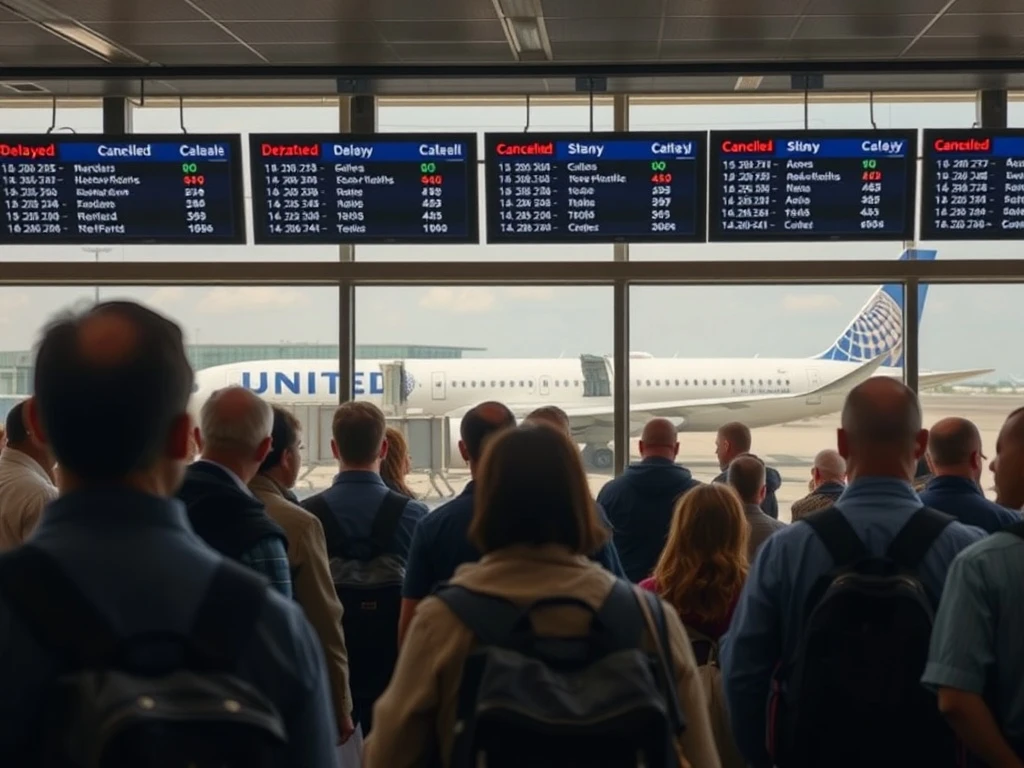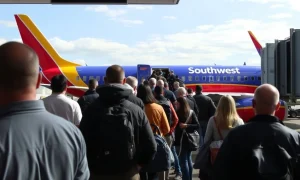Travelers across the United States recently faced significant disruption. Hundreds of United Airlines flights experienced massive delays and groundings. This widespread issue stemmed from an unforeseen technical problem within the airline’s systems. The incident left countless passengers stranded and disrupted travel plans nationwide. Therefore, understanding the scope and impact of these United Airlines delays is crucial for anyone affected by air travel disruptions.
Unprecedented Grounding: Understanding the Scope of United Airlines Delays
On a recent day, United Airlines encountered a critical system failure. This technical issue led to an immediate halt of flights across the U.S. Reports indicated that over 1,000 flights were either delayed or outright canceled. Many travelers felt the direct impact. Major hubs like Chicago O’Hare, Denver International, and Newark Liberty International airports saw the most significant effects. Passengers waited for hours, uncertain about their next steps. Consequently, airport terminals became crowded with frustrated individuals seeking information. This sudden grounding represented a major operational challenge for the airline.
The Federal Aviation Administration (FAA) quickly acknowledged the situation. They issued a ground stop for United Airlines flights. This action aimed to manage air traffic safely during the system outage. Air traffic controllers worked to minimize further complications. The scale of these United Airlines delays was substantial, affecting both domestic and international routes. Furthermore, the incident highlighted the critical reliance of modern aviation on complex digital systems. A single point of failure can thus create widespread chaos.
The Root Cause: Investigating the Technical Glitch Behind United Airlines Delays
United Airlines swiftly identified the source of the problem. A software update caused a critical system malfunction. Specifically, a router configuration issue prevented communication between different operational systems. This technical glitch impacted several key functions, including flight dispatch and weight and balance calculations. Such systems are vital for safe flight operations. Therefore, the airline had no choice but to ground its fleet. Safety protocols dictate that no aircraft can depart without fully functional systems.
Airline officials worked tirelessly to resolve the issue. Their teams collaborated with external technology partners. They isolated the problem and began implementing a fix. This process involved resetting core network components and verifying data integrity. The priority remained restoring full operational capability safely. Ultimately, the rapid response helped mitigate a longer-term crisis. However, the initial impact of the United Airlines delays was undeniable.
- Initial reports cited a ‘technical issue’.
- A router configuration problem was identified.
- This glitch affected flight dispatch and weight/balance systems.
- Safety protocols necessitated the ground stop.
Passenger Plight: Impact of United Airlines Delays on Travelers
The immediate consequence of the grounding was widespread passenger frustration. Thousands of travelers found themselves stuck at airports. Many missed crucial connections. Some travelers faced unexpected overnight stays. Families with young children particularly struggled with the uncertainty. The airline’s customer service lines became overwhelmed. Passengers sought rebooking options and accommodation vouchers. This created a challenging environment for both travelers and airline staff.
Social media platforms filled with passenger complaints. Images of long lines and crowded terminals circulated widely. United Airlines acknowledged the inconvenience. They issued apologies and worked to provide assistance. However, the sheer volume of affected passengers made rapid resolution difficult. The ripple effect of these United Airlines delays extended beyond the initial grounding. Many subsequent flights also experienced knock-on effects. This led to further cancellations and schedule adjustments.
Economic Repercussions: Financial Fallout from United Airlines Delays
Major operational disruptions carry significant financial costs for airlines. United Airlines likely incurred substantial expenses from this incident. These costs include compensation for delayed passengers, rebooking fees, and hotel vouchers. Furthermore, the airline faced lost revenue from canceled flights. Such events also damage an airline’s reputation. This can lead to a decrease in future bookings. Investors often react negatively to such news. Therefore, United’s stock price saw some volatility following the announcement.
The aviation industry operates on tight margins. Even a single day of widespread groundings can impact profitability. This incident serves as a reminder of the fragility of modern transportation networks. Airlines invest heavily in redundant systems. Yet, unforeseen technical glitches can still occur. The long-term financial impact of these United Airlines delays will depend on how quickly the airline can restore public confidence and operational efficiency. Moreover, the incident could prompt greater scrutiny from regulatory bodies regarding system resilience.
Regulatory Oversight: FAA’s Role in Addressing United Airlines Delays
The Federal Aviation Administration (FAA) plays a crucial role in ensuring air travel safety. When a major incident like the United Airlines delays occurs, the FAA steps in. They monitor the situation closely. Their primary concern is always public safety. The FAA issued a ground stop order, as mentioned earlier. This allowed the airline to address the technical issue without risking flight operations. The FAA also conducts investigations into such incidents. They aim to understand the root cause fully. This helps prevent similar problems in the future.
Furthermore, the FAA works with airlines to establish safety protocols. They ensure compliance with aviation regulations. This incident will likely lead to a review of United’s system redundancy. The FAA may recommend or mandate new procedures. Such oversight helps maintain the high safety standards of U.S. air travel. Therefore, the agency’s involvement is vital for restoring public trust. They ensure that all necessary steps are taken to prevent future United Airlines delays of this magnitude.
Restoration and Recovery: United Airlines Delays Begin to Clear
United Airlines worked diligently to resolve the technical issue. Their teams identified the problem within hours. They implemented a fix shortly thereafter. The ground stop was eventually lifted. Flights slowly began to resume operations. However, the recovery process was gradual. The airline needed time to reposition aircraft and crews. They also had to rebook thousands of passengers. This logistical challenge took several days to fully manage.
The airline provided regular updates to passengers. They utilized their app and website to disseminate information. United offered travel waivers for affected customers. This allowed passengers to change their flights without penalty. The airline also offered refunds to those who chose not to travel. Despite the significant disruption, United’s operational teams managed to restore service. The speed of the fix was commendable, given the complexity of the issue. Nevertheless, the memory of these widespread United Airlines delays will linger for many travelers.
Lessons Learned: Preventing Future United Airlines Delays
This incident offers important lessons for the entire aviation industry. Airlines must prioritize robust IT infrastructure. Redundancy and backup systems are critical. Regular testing of these systems is also essential. This helps identify vulnerabilities before they cause major disruptions. Furthermore, effective communication strategies are vital during a crisis. Keeping passengers informed can mitigate frustration. Airlines also need clear protocols for managing large-scale cancellations. This ensures a smoother recovery process.
The United Airlines delays highlight the need for continuous investment in technology. As air travel becomes more reliant on digital systems, so too does the risk of system failures. Proactive measures are always better than reactive ones. Therefore, this event serves as a wake-up call for all carriers. They must ensure their systems can withstand unexpected challenges. This commitment to resilience will benefit both airlines and their passengers.
In conclusion, the recent technical glitch caused significant United Airlines delays and groundings. While the immediate issue was resolved, the incident underscored the critical importance of resilient airline IT systems. Passengers experienced considerable inconvenience, and the airline faced operational and financial challenges. Moving forward, the aviation industry will undoubtedly review these events to bolster system integrity and ensure smoother operations for future travel.
Frequently Asked Questions (FAQs)
What caused the recent United Airlines delays?
A technical issue, specifically a router configuration problem following a software update, caused the widespread United Airlines delays. This glitch prevented critical operational systems from communicating properly.
How many flights were affected by the United Airlines grounding?
Hundreds of United Airlines flights across the U.S. were impacted. Reports indicated over 1,000 flights faced delays or cancellations due to the system outage.
Was the FAA involved in the United Airlines delays?
Yes, the Federal Aviation Administration (FAA) issued a ground stop for United Airlines flights. They closely monitored the situation to ensure safety and manage air traffic during the disruption.
How did United Airlines resolve the technical issue?
United Airlines’ technical teams identified the router configuration problem and implemented a fix within hours. This involved resetting core network components to restore system functionality.
What should passengers do if their flight is affected by United Airlines delays?
Passengers should check the United Airlines app or website for the latest flight status. They can also contact customer service for rebooking options, travel waivers, or refunds, as offered by the airline during disruptions.
What are the long-term implications of these United Airlines delays?
The incident highlights the critical need for robust IT infrastructure and redundancy in airline operations. It may prompt airlines to invest further in system resilience and review emergency protocols to prevent similar widespread disruptions in the future.
























